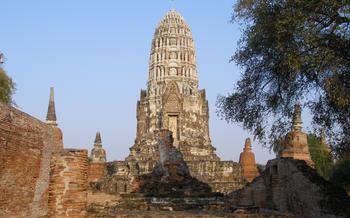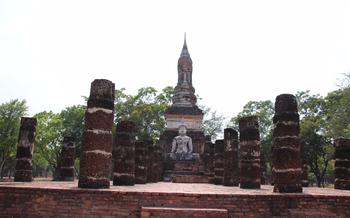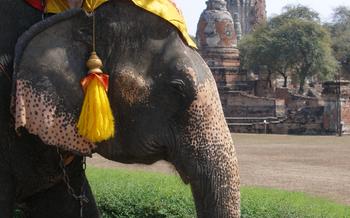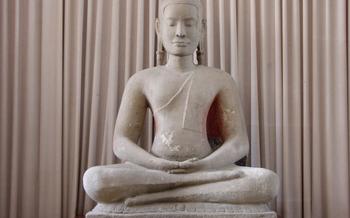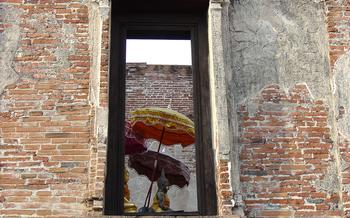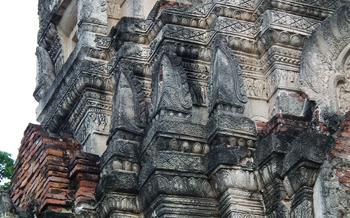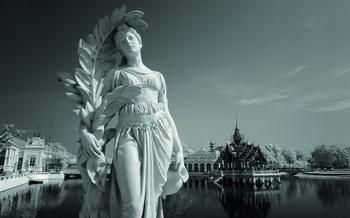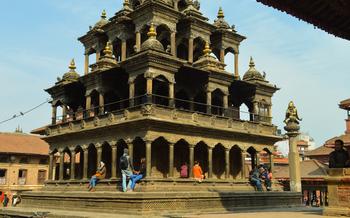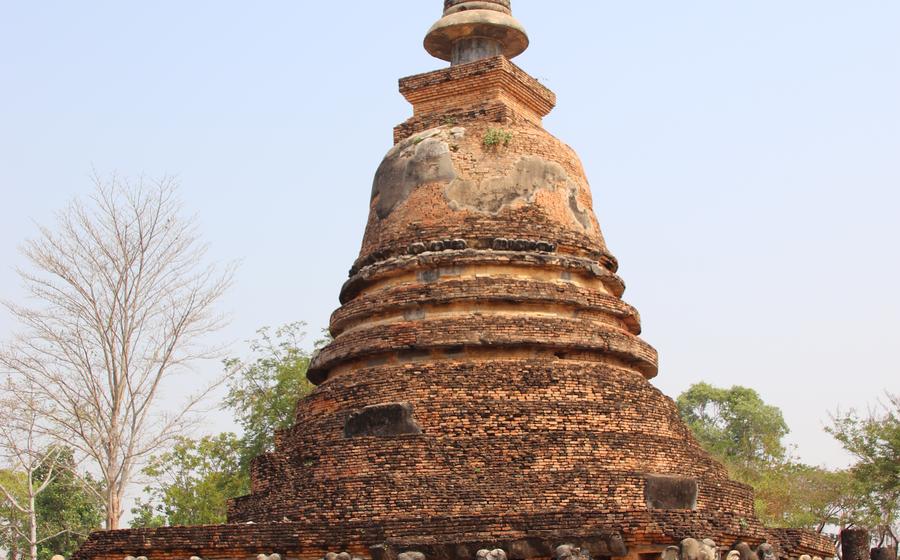
Wat Chang
- Historical Significance:
- Wat Chang Temple Overview
- Giant Reclining Buddha
- Temple Grounds and Architecture
- Historical and Cultural Significance
- Exploring the Temple Complex
- Local Culture and Interactions
- Photography Tips:
- Souvenirs and Local Crafts
- Food and Refreshments
- Other Attractions in Ayutthaya
- Ayutthaya Historical Park
- Transportation Options:
- Insider Tip: A Hidden Treasure
Historical Significance:
Ayutthaya, the ancient capital of Siam, boasts a rich cultural heritage that attracts visitors from around the world. Founded in 1350, it served as the kingdom's political and economic center for over 400 years. During this time, Ayutthaya flourished, becoming a major trading hub and a center of Buddhist learning. Its strategic location on the Chao Phraya River allowed it to control trade routes and amass immense wealth, which is reflected in the city's magnificent temples and palaces. However, in 1767, Ayutthaya fell to the Burmese invaders, who sacked and burned the city, leaving behind only ruins. Despite its destruction, Ayutthaya's legacy lives on, and its historical significance is recognized by UNESCO, which declared it a World Heritage Site in 199Exploring the ruins of Ayutthaya is a journey back in time, allowing visitors to witness the grandeur of a once-mighty kingdom and gain a deeper understanding of Southeast Asia's rich history.
Wat Chang Temple Overview
Wat Chang, meaning "Elephant Temple," stands as one of Ayutthaya's most prominent and iconic temples. Its unique feature is the awe-inspiring giant reclining Buddha, a symbol of peace and serenity that draws visitors from around the world. The temple's architectural style reflects the classic Ayutthaya period, characterized by intricate carvings, colorful murals, and towering stupas. Its historical significance lies in its role as a royal monastery during the Ayutthaya Kingdom, serving as a spiritual and cultural center for the royal family and the community. Wat Chang's well-preserved condition and its representation of Ayutthaya's rich cultural heritage have earned it a well-deserved place as a UNESCO World Heritage Site.
Giant Reclining Buddha
Prepare to be awestruck as you lay your eyes upon the colossal reclining Buddha, the majestic centerpiece of Wat Chang. Towering at 42 meters in length and 8 meters in height, this monumental effigy exudes an aura of serenity and awe that is unparalleled. Carved with exquisite precision from solid brick and stucco, the Buddha exudes an air of timelessness, as if it has witnessed centuries of history unfold before its tranquil gaze.
The reclining posture of the Buddha holds profound symbolic meaning, representing the transition from earthly existence to the ultimate state of nirvana. The Buddha's right hand rests gently upon his thigh, while his left hand supports his head, evoking a sense of peaceful repose. The serene expression on his face radiates an inner calm and detachment from worldly desires.
This colossal masterpiece is not merely an object of admiration but also a testament to the deep devotion and artistry of the ancient Ayutthayan people. As you stand before this magnificent creation, take a moment to reflect on the spiritual significance it holds for countless believers and the enduring legacy of the kingdom of Siam.
Temple Grounds and Architecture
As you wander through the well-preserved temple complex of Wat Chang, you'll be struck by the intricate details and harmonious architecture. Admire the gleaming white stupas, each representing a different stage of Buddha's life. The towering chedis, with their distinctive bell-shaped spires, stand as symbols of spiritual enlightenment. Explore the viharns, or assembly halls, where monks once gathered for meditation and teachings. The intricate carvings and murals adorning these structures depict scenes from Buddhist mythology and the life of Buddha. Take a moment to appreciate the craftsmanship and artistry that went into each element of the temple's design, creating a sacred space that inspires awe and tranquility.
Historical and Cultural Significance
Wat Chang stands as a testament to the rich religious and cultural heritage of Ayutthaya. It was once a royal monastery, closely associated with the monarchy and the ruling elite. The temple played a crucial role in royal ceremonies, religious festivals, and the ordination of monks. It was a center of learning and spiritual guidance for the community, attracting devotees from all walks of life.
Throughout its history, Wat Chang has undergone several renovations and expansions, reflecting the changing artistic styles and religious practices of different eras. The temple's architecture, sculptures, and murals depict various aspects of Thai mythology, history, and Buddhist teachings. It offers a glimpse into the beliefs, values, and artistic expressions of the ancient Siamese people.
Today, Wat Chang continues to be an active place of worship and a popular destination for pilgrims and tourists alike. Visitors can witness monks performing daily rituals, participate in meditation sessions, and receive blessings from the resident abbots. The temple's vibrant community of monks and devotees keeps its spiritual traditions alive while welcoming visitors to share in the rich cultural heritage of Ayutthaya.
Exploring the Temple Complex
As you step through the gates of Wat Chang, a world of ancient grandeur unfolds before your eyes. Wander through the serene courtyards, lined with well-preserved structures that whisper tales of a bygone era. Marvel at the intricate carvings adorning the stupas and chedis, each a testament to the artistry and devotion of the ancient Ayutthayan people.
Don't miss the ordination hall, a sacred space where young men were once initiated into the Buddhist monkhood. Admire its elegant architecture and the beautifully painted murals that adorn its interior. The bell tower, with its towering spire, is another must-see. Climb to the top for panoramic views of the temple grounds and the surrounding countryside.
Take time to explore each section of the temple complex, immersing yourself in its rich history and spiritual significance. Discover the meditation chambers, where monks sought inner peace and enlightenment. Wander through the libraries, where ancient scriptures and teachings were preserved for future generations.
As you explore, remember that Wat Chang is an active place of worship. Be respectful of the monks and other visitors, maintaining a quiet and contemplative demeanor. Embrace the opportunity to learn about Buddhism and Thai culture by observing the daily rituals and ceremonies that take place within the temple grounds.
Local Culture and Interactions
Engaging with the local community is an enriching experience that offers a glimpse into the vibrant culture of Ayutthaya. Visitors can interact with the friendly monks who reside at Wat Chang and learn about their daily lives and Buddhist teachings. There are opportunities to participate in temple activities such as meditation sessions or alms-giving ceremonies, which provide a unique insight into Thai religious practices. It is important to be respectful and mindful of local customs and traditions when interacting with the monks and other visitors. By immersing oneself in the local culture, travelers can gain a deeper understanding of Thailand's rich heritage and create lasting connections with the people of Ayutthaya.
Photography Tips:
To capture the grandeur of Wat Chang and its giant Buddha, consider these photography tips:
-
Best Angles: Photograph the reclining Buddha from different angles to capture its size and details. Move around the statue to find unique perspectives.
-
Lighting Conditions: Visit the temple during the golden hours, around sunrise or sunset, for warm and diffused light that enhances the temple's beauty.
-
Respect the Sacredness: Remember that Wat Chang is a sacred site, so be respectful when taking photographs. Avoid using flash or posing in inappropriate ways.
Souvenirs and Local Crafts
While exploring Wat Chang, take the opportunity to support local artisans and preserve traditional crafts by purchasing souvenirs and local crafts. Ayutthaya is known for its intricate wood carvings, exquisite silk textiles, and beautiful ceramics. Visit local shops or markets to find unique items such as hand-carved wooden sculptures, colorful silk scarves, and ceramic bowls or figurines. These souvenirs will not only serve as mementos of your visit but also contribute to the livelihoods of local craftspeople. When making purchases, remember to bargain politely and respectfully. Your support for local crafts helps preserve Thailand's rich cultural heritage and ensures that these traditional skills continue to thrive.
Food and Refreshments
After exploring the serene grounds of Wat Chang, visitors can satisfy their appetites with a culinary adventure in Ayutthaya. The city boasts a diverse range of restaurants and food stalls, offering both local delicacies and international cuisine.
For an authentic Thai experience, head to one of the many street food stalls lining the streets. Sample mouthwatering dishes such as pad thai, a stir-fried rice noodle dish with vegetables and your choice of protein, or khao soi, a flavorful curry noodle soup with crispy noodles.
For a more upscale dining experience, visit one of the many restaurants in Ayutthaya's historic center. Many of these establishments offer stunning views of the ancient temples and ruins, creating a memorable ambiance for your meal.
Be sure to try some of the local specialties, such as pla chon pao, a dish made with grilled snakehead fish wrapped in banana leaves, or khao chae, a fragrant rice dish served with iced jasmine tea and various toppings.
Supporting local businesses is an important part of experiencing Ayutthaya's culture. By dining at local restaurants and food stalls, you contribute to the preservation of traditional Thai cuisine and support the local community.
Other Attractions in Ayutthaya
While Wat Chang is a must-see, Ayutthaya offers a wealth of other attractions that showcase its rich history and cultural heritage. Don't miss the opportunity to explore the following sites:
- Wat Phra Mahathat: This iconic temple is known for its towering prang (spire) that has become a symbol of Ayutthaya. Marvel at the giant Buddha head entwined by tree roots, a poignant reminder of the city's past.
- Wat Phra Si Sanphet: Once the grandest temple in the kingdom, Wat Phra Si Sanphet was the spiritual center of Ayutthaya. Explore the ruins of its three main stupas, which once housed the ashes of Ayutthaya's kings.
- Chao Sam Phraya National Museum: This museum houses a vast collection of artifacts from Ayutthaya's glorious past, including Buddha images, ceramics, and ancient weapons. It offers a deeper insight into the kingdom's history and culture.
- Ayutthaya Floating Market: Experience the vibrant local culture at this bustling floating market. Vendors in traditional boats sell fresh produce, handicrafts, and delicious Thai cuisine. It's a great place to soak up the atmosphere and try some local delicacies.
Plan a full day or multiple days in Ayutthaya to truly immerse yourself in its captivating history and diverse attractions. Discover the charm of this ancient city and create lasting memories of your journey through Thailand's rich cultural heritage.
Ayutthaya Historical Park
Ayutthaya Historical Park, a UNESCO World Heritage Site, is a must-visit destination for anyone interested in the history and culture of Thailand. The park encompasses the ruins of the ancient city of Ayutthaya, once the capital of the Kingdom of Siam. Within the park, visitors can explore various temples, palaces, and other historical structures that provide a glimpse into the city's glorious past.
To fully appreciate the park's significance, consider hiring a knowledgeable guide or embarking on a self-guided tour with a detailed map. The guide will provide insights into the history and significance of each site, while the map will help you navigate the vast park efficiently.
Among the park's highlights are the ruins of the Grand Palace, once the residence of the Siamese kings. The palace complex boasts impressive architecture, including throne halls, audience chambers, and royal residences. Other notable structures include the Wat Mahathat, known for its iconic Buddha head entwined by tree roots, and the Wat Phra Si Sanphet, the former royal temple of the Ayutthaya Kingdom.
A visit to Ayutthaya Historical Park is an immersive journey into the past, allowing visitors to experience the grandeur and splendor of the ancient Siamese kingdom. Whether you choose to explore independently or with a guide, the park offers a unique and enriching experience for history buffs and culture enthusiasts alike.
Transportation Options:
Getting around Ayutthaya is a breeze with various transportation options available. Tuk-tuks, the iconic three-wheeled vehicles, are a fun and affordable way to navigate the city's streets. Simply hail one down on the roadside and negotiate a price before hopping in. Taxis are also readily available and offer a more comfortable ride, especially for longer distances.
For those who prefer a more active mode of transportation, bicycle rentals are a great option. Cycling through the ancient city allows you to soak in the sights and sounds at your own pace. Several rental shops are located near Wat Chang, making it easy to pick up a bike and start exploring.
When traveling between Wat Chang and other attractions, tuk-tuks and taxis are the most convenient options. Simply inform the driver of your destination, and they will take you there directly. If you're exploring the Ayutthaya Historical Park, consider renting a bicycle to easily maneuver through the vast complex of ruins and temples.
Insider Tip: A Hidden Treasure
Venture beyond the main temple grounds and discover a hidden gem known only to a few. Tucked away in a serene corner of the complex, you'll find a secluded pond surrounded by lush vegetation. Here, you can witness a rare sight—a magnificent albino catfish swimming gracefully in the tranquil waters. This elusive creature is considered a sacred symbol of good fortune, and catching a glimpse of it is believed to bring blessings. As you stand in awe of its ethereal beauty, take a moment to reflect on the hidden wonders that await those willing to explore beyond the ordinary.
